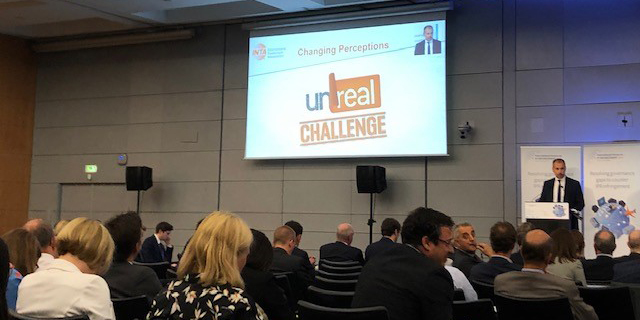INTA News
INTA Leaders Propose Anticounterfeiting Solutions at Forum in Paris
Published: June 25, 2019
Hadrien Valembois INTA Policy Officer, Europe

INTA 2019 President David Lossignol (Novartis, Switzerland) provides the ‘Industry’s perspective’ on IP enforcement at the EUIPO-OECD IP Enforcement Forum in Paris on June 12.
Intellectual property (IP) professionals and government officials gathered in Paris, France to discuss solutions related to global counterfeiting and ways to bolster collaborative IP enforcement strategies at the International Forum on IP Enforcement 2019, on June 12-13.
This high-level IP forum brought together key European and international decision makers, enforcement agencies, multinational companies, and other private actors (brand owners and online platforms), as well as relevant stakeholders to discuss trends and alternative enforcement techniques for IP both at the EU and global levels. Key speakers included Vishal Amin (IP Enforcement Coordinator, White House, USA), Christian Archambeau (Executive Director, EUIPO), and SÅ‚awomir Tokarski (Director, DG GROW, EU Commission).
INTA 2019 President David Lossignol (Novartis AG, Switzerland) provided an industry perspective at the beginning of the forum’s first day. Mr. Lossignol emphasized two key messages to combat the proliferation of counterfeiting: collaboration and changing perceptions. On the first point, he said, “We need a team effort-in all countries, with all stakeholders, with all generations. The issue is too large for any one brand or one government authority to tackle alone.” Secondly, he called for raising awareness and educating consumers, especially youth, to change perceptions, noting “We must educate early and educate often.”
Mr. Lossignol provided an overview of the key findings of INTA’s “Gen Z Insights: Brand and Counterfeit Products” study, which highlights the attitudes of Gen Z consumers in 10 countries toward purchasing counterfeit products and the factors that might change their behaviors. Among education solutions, he pointed to INTA’s Unreal Campaign, which raises awareness among young consumers about the dangers of counterfeits and emphasizes the importance of trademarks and brands.
Also at the event, the European Intellectual Property Office and EUROPOL unveiled their 2019 Intellectual Property Crime Threat Assessment, an update to previous editions released in 2015 and 2017. The report assesses the threat posed by counterfeiting and piracy in the EU in several product sectors, as well as cross-cutting factors that influence or impact the criminal environment.
The report stresses that counterfeit and pirated goods are increasing, amounting to as much as 6.8 percent of EU imports, or €121 billion. It also notes a decrease in customs’ detention of counterfeits since 2013, “even if the number of items seized and their estimated value has decreased at a lower pace, with a temporary recuperation in 2015 and 2016,” though this decline is mainly due to the effectiveness of customs’ operations. In addition, it points out that most counterfeit items still come from China.
The forum included sessions focused on the role of intermediaries in the fight against counterfeiting. Brand owners asked online platforms to intervene more proactively, and online intermediaries showcased the measures they are already taking, including reactive measures and take downs.
Government officials, notably the European Commission, defended, on its end, voluntary measures, such as its own Memorandum of Understanding with Internet platforms, rights owners, and associations to prevent offers of counterfeit goods from appearing in online marketplaces. On this front, INTA Vice President Zeeger Vink (Maus Frères, France) raised a possible solution, namely traders’ identification when they sell online, since “all the enforcement tools in the world are useless” if you cannot identify the counterfeiters.